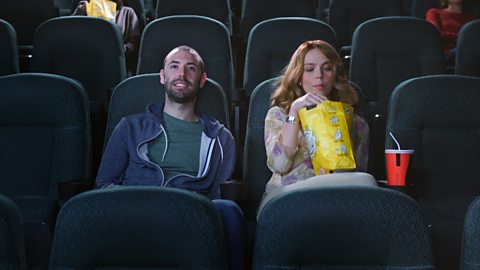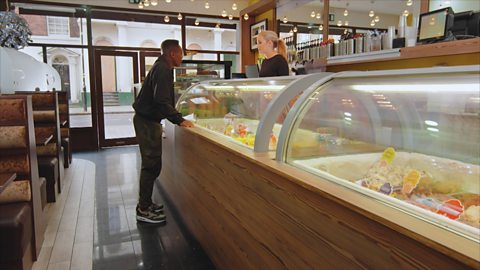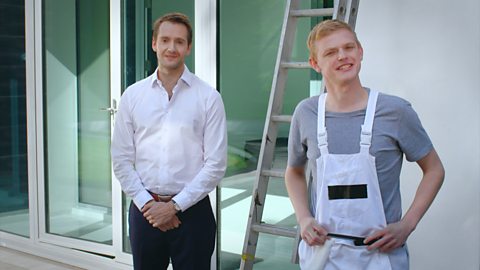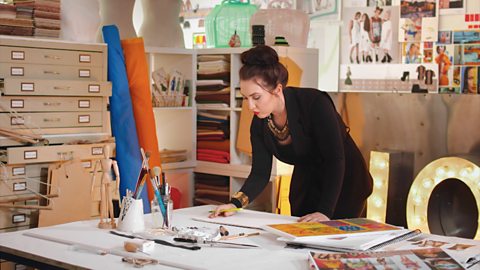MARY:Right. 200g of self-raising flour, 175g of butter, 2 eggs. 225g of Caster sugar, 40g of cocoa powder, one teaspoon of vanilla extract and the cream, 150ml.
MARY:When do you need them for?
MARY:Two hours?!
MARY:No, that won't be a problem.
MARY:Sure, that's fine. 10 chocolate sponges at 5pm.
MARY:OK, so what will I need for 10 cakes?
MARY:'If two quantities arein direct proportion,as one increases, the otherincreases by the same amount.So if I use twiceas many ingredientsI will make twice as many cakes.
MARY:'So Y is directly proportional to X.if I double the quantitiesrequired for four cakes,I will have the quantitiesrequired to produce eight cakes.
MARY:'And if I halve the quantitiesrequired for four cakes,I will have the quantities neededto produce two cakes.And the sum of each quantityrequired for both eight and two cakeswill give me the quantitiesrequired for 10 cakes.
MARY:I won't manage to get both orderscompleted on time.
MARY:Now, with four of them helping me, we will be able to finish in three hours. I still need to make the cakes I've started, so what if I ask for two more people to help? How long would it take if I had six helpers?
MARY:'Well, inverse proportion is when one value increases as the other value decreases, so as the number of equally productive helpers increases, the time taken to complete the task decreases.
MARY:'I can use the equation T equals K over N, where T stands for the number of hours, K for the constant of proportionality, which is the constant value of the ratio of two proportional quantities, and N for the number of people helping.
MARY:'So I need to find the constant of proportionality, which is K, and the value of T, when N is six. I know that, with four people helping, it will take three hours, so three is equal to K over four.
MARY:'And if I multiply both sides of the equation by four, then three multiplied by four is equal to the value of K, so K equals 12.
MARY:'Now, for six helpers, I can substitute the valuesof K and N into the equation, so T is equal to 12 over six, therefore, T equals 2.
MARY:'Which means, with six helpers, the 10 cakes will be completed in two hours.'
MARY:Great.
Video summary
This short clip demonstrates how ratios are used in everyday life by cooks to make recipes - dividing an amount into given parts.
The video clip shows a cake company that needs to deliver an order within a specified time frame.
The clip looks at increasing ingredients in direct proportion, and deciding how many workers need to be hired to complete the order in 2 hours.
This is from the series: Real Life Maths
Teacher Notes
The video could be used as real life examples of how ratio and inverse proportion calculations can be used to solve problems.
It follows a step-to-step guide using graphics and visuals to support calculations to reinforce and enhance learning in the classroom.
Learners in pairs or groups of no more than 3 students choose to open a company (teacher could give the students a list of companies to choose from).
They investigate ratio and proportion, such as staffing, delivering orders on time, profitability, Economic growth and mathematical justification such as increase in productivity, and the effect on company turn over.
The results and findings can be represented in a presentation using ICT.
Students could investigate stand-alone projects in finding how Nurses calculate proportional dosage to patients and how they use ratio/proportion.
How ratio and proportion are used in the banking world or Biologists and ecologists.
Students can also use the Internet to investigate ‘proportional’ representation and the electoral system.
This clip will be relevant for teaching Maths at KS3/GCSE in England Wales and Northern Ireland. Also at National 4, 5 and Higher in Scotland.
This topic appears in OCR, Edexcel, AQA, WJEC in England and Wales, CCEA GCSE in Northern Ireland and SQA in Scotland.
Percentages. video
Clothes shopping and video statistics are used to explain percentages.

Algebra. video
A mobile phone deal and a trip to the cinema are used to explain algebra.

Sequences. video
The purchasing of cupcakes is used to explain linear and quadratic sequences.

Pythagoras. video
Cleaning a window and installing a TV are used to explain the theory of Pythagoras.

Probability. video
Predicting the weather and choosing a chocolate are used to explain probability.

Trigonometry. video
A hiker trying to work out the height and distance he's walked uses trigonometry.

Fractions. video
A group of friends sharing a meal is used to explain fractions.

Geometry. video
A clothes designer trying to make an outfit uses geometry.

Finance. video
A man buying a car uses financial planning and investment to work out how much he'll pay.
